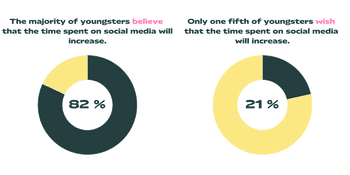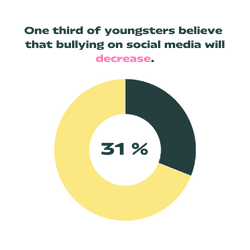The Social Media of Dreams: What youngsters wish from future social media
Together with TietoEVRY we surveyed what young people in Finland wish for the future social media. We found out that the social media of Finnish youngsters’ dreams is based on soft values and mutual respect. There is still a long way to go before we reach this goal. At the end of the survey, we have listed recommendations on how the social media of young people’s dreams can be created.

Prologue
The young generation has grown up on social-media platforms. Studies show that even before COVID-19 youngsters spent approximately 15–20 hours a week on social media. This has increased during the pandemic. The things that happen on social media influence young people’s lives enormously – both now and in the future.
Our survey shows that young people in Finland are worried that bullying and hate speech cannot be controlled on social media, and that this will continue in the future. Yet they see enormous potential in social media as a way to influence matters of importance to them.
So, it is high time to include young people in the debate about the future of social media. Our survey shows that youngsters in Finland have a lot to say, and that they assess social media and their use of it in an analytical, proficient, and critical manner.
The social media of their dreams, which can be seen in their answers, is safe, equal and makes the world a better place. We have a long way to go to this dream. At the end of the survey, there are recommendations for different groups on how we could create the kind of social media that young people dream of.
Olli Alanen
Executive Director
Children and Youth Foundation
Kia Haring
Head of Communications and Sustainability
TietoEVRY
How the survey was performed
The “Social media of dreams” survey was answered by 731 youngsters in Finland between the ages of 15 and 18 during the period 11 to 18 March 2021. The respondents represent the population of their age. The error rate of the survey is 2.1 to 3.7 percentage points
- Of the respondents, 48% were girls and 49% boys, while 1% were others and 2% did not wish to answer the question on gender
- The respondents lived in different parts of Finland
- The respondents were given statements on the future of social media, and they assessed how likely and desirable they found them
- “Future” in the enquiry refers to the time five years from now
- The data was gathered by Aula Research Oy
- The data was analysed by the Children and Youth Foundation
The survey is part of the co-operation between the Children and Youth Foundation and TietoEVRY against hate speech and cyberbullying. The aim of the co-operation is to improve interaction on digital platforms and thereby increase the wellbeing of young people. The co-operation has resulted in, for instance, the Polite Type font, which corrects hate speech automatically and makes youngsters think of their choice of words. Read more about the font: www.ThePoliteType.com
What does the social media of young people’s dreams look like?
For young people, the social media of their dreams is above all a safe place where people can be themselves; a place where different opinions are understood and where you can share your life without glamourisation or filters.
On social media you can also promote things that are important to you. Everybody, even minorities, get their voices heard equally. Young people believe that social media can improve social debate and they will use social media intentionally for expanding their worldviews.
The greatest threat to this dream is that bullying and hate speech cannot be controlled on social media. Young people fear that bullying will continue on social media, even though they naturally do not wish this to happen. Perhaps this is why young people believe and hope that moderation will increase on social media platforms.
Young people are especially worried about one thing. They believe that social media will occupy even more of our time in the future, even though they do not wish this to be the case. Instead, young people wish that they could spend more time together outside social media.
All in all, the answers show that young people are up-to-date and analytical. They see a lot of opportunities in the development of social media, but they also see threats.
It is interesting that there were major differences between genders in the answers. Girls identified more threats in the development of social media than boys. Girls also saw more opportunities.
It is also worth noting that 15-year-olds differed from older respondents in many respects, as they were more optimistic about the future of social media. The older youngsters get, the more critically they also identify the downsides of social media.
The 10 most important findings of the survey
82% of respondents believed that young people would use social media even more five years from now. Only 21% of the respondents would like to see people using even more time on social media in the future
72% of respondents believed that social media would in the future have a greater impact on young people’s identity building. But only 24% wanted this to be the case
78% of respondents felt that young people would use social media even more in the future in order to expand their worldviews
58% of respondents believed that people would, thanks to social media, understand other people’s opinions and views better than before. 14% of respondents did not believe this would be the case
57% of respondents believed that people would share their lives in a more sincere and less glamourised manner in the future. Only 14% of the respondents did not believe that this would be the case
74% of respondents believed that social media influencers would have a greater impact on the lives of young people in future
75% of respondents believed that through social young people could have greater influence than today over matters they find socially important
62% of respondents believed that representatives of minorities would be better heard on social media in the future. Only 12% believed that this would not be the case
63% of respondents found it likely that moderation and supervision would increase on social media. 22% of respondents did not wish that supervision would increase
In open answers, young people were especially worried that bullying, discrimination and hate speech would be even less controlled in the future.
Who am I and how do social media influence me?
The majority of youngsters spend several hours a day on social media, which means that social media and the things encountered there influence the wellbeing of youngsters and the building of their identity. On the basis of the survey, young people identify this themselves.
The use of social media will increase even though youngsters would like to have more time face to face
According to studies, young people spend more time on social media from year to year, and they believe that this trend will continue: almost all respondents (82%) believed that young people would spend even more time on social media five years from now. It is worth noting that only 21% of the respondents wished that people would spend more time on social media in the future.
The difference between boys and girls was significant. Only 12% of girls wished that young people would spend more time on social media in the future, while almost one third (30%) of the boys wished that the time spent on social media would increase. In open answers, one of the most common threats associated with the future of social media was that “our entire lives go over to social media”.
The survey shows that the majority of youngsters (67%) would like to spend more time together outside social media. It is alarming that only one fourth found it likely that this would happen. Only 9% of the respondents said that they would not want the time outside social media to increase.
The difference between genders was clear. Girls wished more often than boys that youngsters would spend more time together outside social media. 75% of girls and 59% of boys had this wish. It is also interesting that boys found it more likely than girls that the time spent outside social media would increase.
One third (32%) of the boys assessed that the time on social media would increase, while only 16% of the girls believed in this. It is worth noting that older respondents wish that the time outside social media would increase more often than younger respondents. At the same time, older respondents also found this more unlikely than younger respondents.
In their open answers, youngsters said that they are afraid of the following things, for instance:
“That the whole life is based on and goes round social media.” – respondent, 18
“That nobody notices you, if you are not active on social media.” – respondent, 17
”That social media will begin to replace real human relations more and more.” – respondent, 17.
Young people wish to share their lives as they are, without glamourisation
Social channels are often accused of painting a romanticised picture: good things are emphasised, and bad things are blurred. It is worth noting that the majority of the respondents (57%) believed that people would share their lives in a more realistic and less romanticised manner in the future. Only 14% did not believe that this would happen.
Young people also found it important that social media would be “truer than before”. 60% of the respondents wished for a change towards less glorified social media, and only 9% did not wish this to happen. There was also a clear gender difference: girls wished for truer social media clearly more than boys. Older respondents also found this more important than younger respondents.
On social media, interaction mostly takes place through written text, but the importance of pictures and videos has increased constantly. 63% of the respondents believed that the importance of pictures and videos would increase at the expense of text content.
The form of the content does not seem to be very important to youngsters: 45% answered that it does not matter whether the amount of text decreases or not, as social media become more visual. Younger respondents in particular wished to have more audio-visual content on social media.
The role of influencers in young people’s lives is emphasised
Social media influences the way in which young people’s identities are built. They know this and do not think that it is a good thing. 72% of the respondents believed that the importance of social media in building the identities of young people will increase in future. Only one fourth (24 %) wished that this would happen, however. Girls found this scenario more likely and less desirable than boys. Older respondents also thought that this would be more likely and less desirable than younger respondents thought.
Social media influencers have a great impact on young people’s lives. Youngsters believed that this impact would only increase in the future. The majority of the respondents (74%) believed that influencers would have an even greater impact on young people’s lives in the future.
When young people were asked if they wished that the role of influencers would increase, the answers were rather evenly distributed. 28% of youngsters felt that this development was positive and 35% that is was undesirable. 34% answered that it was of no importance.
Girls thought that the increasing role of influencers in the everyday lives of youngsters was more likely. Older respondents had a more negative attitude towards the increasing role of influencers than younger respondents. Influencers usually earn at least part of their living through social media. An interesting detail was that the respondents believed that more and more youngsters would earn money through social media (72%), and half of the respondents also wished that this would be the case. Boys hoped that the possibilities to earn money would increase.
In their open answers, youngsters analysed the impacts of social media like this, for instance:
”Social media are too superficial and give youngsters who are still trying to find out who they are a false view of the world and the idea that you should look in a certain way in order to feel that you belong.” – respondent, 18
“The thought that social media make youngsters believe that their lives should fit into a model of some kind in order to be good frightens me.” – respondent, 17
“Kids develop in the wrong direction.” – respondent, 18.
Youngsters are afraid that bullying will not decrease
According to studies, bullying has increased markedly on social media during the past few years. Therefore it is not a surprise that a large share of the respondents (39%) did not believe that bullying would decrease in the future. On the other hand, almost every third (31%) respondent believed that bullying would decrease. A little less than one third (26%) did not have an opinion.
Even here there was a clear difference between genders: boys believed that bullying would decrease while girls did not. In the open answers, increasing bullying was one of the major threats associated with the future of social media.
It is interesting that the majority of the respondents (62%) believed that moderation and supervision would increase on social media, and more than one half also wished that this would happen (55%). Only one fifth (22%) did not wish this and one fifth (21 %) answered that the question was of no importance to them. Girls wanted to have more moderation than boys.
The world will be a better place thanks to social media
The role of social media in society has been discussed a lot during the past few years. The debate on social media has often been seen as an argument between two extremes, and increasing hate speech is a real problem. Young people want to see this in another way.
They believe that social media will in the future be used for expanding one’s worldview and for influencing matters that one finds important. In addition, respondents believe that interaction on social media will improve.
A forum for influencing and expanding one’s worldview
Based on the survey, young people see great opportunities for building a better society on social media. The majority of the respondents (78%) felt that young people would use social media more for expanding their worldviews five years from now. The majority of the respondents also wished that this would be the case (54%).
Girls wished clearly more often that boys that social media would be used more for expanding one’s worldview. 60% of girls and 45% of boys wished this. Girls also felt that this development would be more likely than boys thought.
The respondents also believed that young people could influence matters that they find socially important more through social media in the future. The majority of the respondents also wished that this would be the case (71%). Only a few percentage points of the respondents did not wish this. Even in this matter, girls both wished more that this would happen and found it more likely than boys. Older respondents wished this more often than younger ones.
People understand each other better thanks to social media
During the past few years, social debate on social media has become more and more polarised. Based on the survey, young people believe, however, that social debate will be more diverse in future thanks to social media. 58% of the respondents believed this would be the case, while only 10% did not believe that this would happen. Girls believe in increased diversity more often than boys did.
In addition, 58% of the respondents believed that people would understand each other’s opinions better in the future thanks to social media.
In their open answers, youngsters took up their concern about the culture of dialogue on social media, i.e. the dialogue is too serious and even conceptual errors that might seem small may lead to problems.
You can no longer tell jokes about anything – one wrong word and everybody feels insulted.
The majority of youngsters (58%) believed that interaction on social media will be better five years from now. Only a very small minority (8%) of the respondents disagreed on this. No less than 28% of the respondents said, however, that this is of no importance to them. In the open answers, youngsters expressed their concerns on the continuing polarisation of the debate.
I am afraid that the debate becomes more polarised, and people are not at all willing to listen to other people’s opinions. I am also afraid that that fake news and harmful content will become even more common.
As for misunderstandings, the respondents were not as optimistic. 28% of the respondents feel that there will be less misunderstandings on future social media. One third had no opinion about this, while 32% of the respondents disagreed. Boys believed more often than girls that misunderstandings would decrease, and younger respondents more often than older ones.
Minorities get their voices better heard
The respondents were optimistic about the position of minorities and believed that they would be better heard on the social media of the future. Most of the respondents (62%) believed this would happen, and only a small minority (12%) believed that this would not be the case. Girls found this more likely than boys and older respondents more likely than younger respondents.
In their open answers, youngsters described the social media of their dreams like this, for example:
“A place where people are equal, behave in a friendly and respectful manner towards each other, where all people are accepted as who they are, where nobody would bully each other, where people could talk about things that are important to them and try to influence them.” – girl, 16
“Where you can present your opinions freely.” – boy, 16
“People would be able to express themselves freely and nobody would be bullied for things that they cannot influence themselves, for instance, like colour of skin or appearance.” – other, 17
“A combination of Instagram and Discord.” – boy, 16
“On the social media of my dreams the faults of people are accepted, and people are allowed to grow. Today, this aspect is disappearing from social media due to cancel culture: nobody dares to make any mistakes or can learn from them.” – other, 18
“There are no social media of my dreams, as I do not particularly like social media.” – girl, 17.
Recommendations: What should happen so that the social media of youngsters’ dreams could come true?
Young people cannot alone build the social media of their dreams. Decision-makers, teachers, parents, journalists, companies and social-media influencers – all of us – are needed. Measures must be taken in many areas of society before these dreams can come true.
How can we support the development trend of social media that youngsters dream of and, at the same time, minimise the downsides and threats that young people identify? The experts at the Children and Youth Foundation have gathered recommendations for different groups on how they can take the observations from the survey into consideration in practice and make the youngsters’ wishes come true.
Do you belong to one of the groups below?
Teacher!
Bullying at school is easily transferred to social media, and vice versa. It is important to explain in the classroom how youngsters can control their own privacy with the tools presented by social media, and what to do if they are subject to cyberbullying. It is also important to teach them that laws are also applicable to social media and a crime is a crime regardless of the medium.
It is also good to discuss the algorithms of social media. Due to them, users only see certain content that the algorithm recommends to them. Could you compare what kind of things different pupils see on the same social medium?
Young people believe that it is possible to build a better world with social media. Could this observation become a more essential part of schoolwork? What would be an important change for your group that you could try to influence together through social media?
Journalist!
Do not treat young people as a) a unified group b) a group grown into social media that does not understand the problems related to social media.
Take up the wishes of young people and offer them possibilities to participate in social media. Young people believe that they can expand their worldviews through social media and, consequently, understand each other better. It is possible for the media to carry out this vision and build a dialogue between different groups outside social media as well.
Young people would like to have more moderation on social media. Should your platform moderate the discussions on it more than now? Present the wishes of young people to the companies that develop social media as well and challenge them to tell what they intend to do in order to make young people’s wishes come true.
Social media company!
Please understand that your algorithms and revenue logic influence the wellbeing and identity of young people and thereby our entire society.
Include youngsters and representatives of minorities actively and truly in the development of your products as early as possible. Build a more positive debate culture and add moderation in order to control hate speech and bullying on your platform.
Internally define a plan that steers your operations and describes what concrete measures and choices you are going to make in order to build the social media of young people’s dreams.
Parent!
The most important thing is to know what your children do on social media and who they follow. At the moment, probably five of the very greatest idols of your teenager are social media influencers such are YouTubers. Do you know what kind of a worldview they present for your teenager?
Remember that social media offer young people a lot of good things. But you cannot ignore the adverse effects, and even youngsters themselves identify them.
Discuss the good and bad things about social media openly at home. Try to understand how the revenue logic of social media functions, what happens on social media and how this influences your child. Discuss together how social media could be used for promoting social matters that are important for your child.
Remember to spend time together even outside social media.
Political decision-maker!
Take into consideration the growing power of social media companies and make decisions based on expert information in order to restrict this power. Do your best so that young people’s wishes for a more diverse social debate and making the voices of minorities heard would come true.
Remember your responsibility as decision-maker and pay attention to your own behaviour on social media. Ask, listen and dare to admit that you did not know or that you were wrong.
Before the era of social media, it was much harder for young people to influence society. Offer young people true possibilities to influence on social media, which they wish for, and include the information that you have gathered during the discussions in decision-making processes. If you find it difficult to get acquainted with different social media, bring a youngster onto your team to tell you more about social media. This can be done during the school’s work practice period, for example.
Adult using social media!
Be an example: listen, behave well and let different voices be heard. Admit when you do not know and be happy when you learn!
Most of the people who behave badly on social media are adults. Stop and think before you publish something! Would you say the same thing face to face and does you message contribute to the social media of young people’s dreams?
Spend some time outside social media, as youngsters will learn from your example.
Sources (in Finnish)
Tieto & Trendit: Vihapuhe, nettikiusaaminen ja häirintä koskettaa erityisesti nuoria
Lauri Hietajärvi, Janne Matikainen: Acadsci: Sosiaalinen media on vuorovaikutusta tukeva ympäristö
The survey is part of the co-operation between the Children and Youth Foundation and TietoEVRY against hate speech and cyberbullying. The aim of the co-operation is to improve interaction on digital platforms and thereby increase the wellbeing of young people. The co-operation has resulted in, for instance, the Polite Type font, which corrects hate speech automatically and makes youngsters think of their choice of words.
Additional information
Ask about the survey
Olli Alanen
Executive Director
olli.alanen@nuori.fi
+358 50 502 5007
Ask about Polite Type
Head of Communications and Sustainability
Kia Haring
kia.haring@tieto.com
+358 40 765 3700




